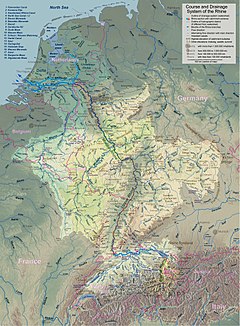Upper Rhine River Plains
| Rhine (Rhenus, Rein, Rhein, le Rhin,Rijn) | |
| River | |
|
The Lorelei rock in Rhineland-Palatinate
|
|
| Name origin: Celtic Rēnos | |
| Countries | Switzerland, Liechtenstein, Austria, Germany, France, Netherlands |
|---|---|
| Rhine Basin | Switzerland, Liechtenstein, Vorarlberg, South and Western Germany, North-Eastern France, Belgium, Netherlands, Italy, Val di Lei |
| Region | Central and Western Europe |
| Primary source | Vorderrhein/Rein Anteriur |
| - location | Tomasee (Romansh: Lai da Tuma), Surselva, Graubünden, Switzerland |
| - elevation | 2,345 m (7,694 ft) |
| - coordinates | 46°37′57″N 8°40′20″E / 46.63250°N 8.67222°E |
| Secondary source | Hinterrhein/Rein Posteriur |
| - location | Paradies Glacier, Graubünden, Switzerland |
| Source confluence | Reichenau |
| - location | Tamins, Graubünden, Switzerland |
| - elevation | 585 m (1,919 ft) |
| - coordinates | 46°49′24″N 9°24′27″E / 46.82333°N 9.40750°E |
| Mouth | North Sea |
| - location | Hoek van Holland, Rotterdam, Netherlands |
| - elevation | 0 m (0 ft) |
| - coordinates | 51°58′54″N 4°4′50″E / 51.98167°N 4.08056°ECoordinates: 51°58′54″N 4°4′50″E / 51.98167°N 4.08056°E |
| Length | 1,230 km (764 mi), |
| Basin | 185,000 km2 (71,429 sq mi) |
| Discharge | |
| - average | 2,900 m3/s (102,413 cu ft/s) |
| - max | 13,000 m3/s (459,091 cu ft/s) |
| - min | 800 m3/s (28,252 cu ft/s) |
| UNESCO World Heritage Site | |
| Name | Upper Middle Rhine Valley |
| Year | 2002 (#26) |
| Number | 1066 |
| Region | Europe and North America |
| Criteria | (ii)(iv)(v) |
|
Map of the Rhine basin
|
|
The Rhine (Latin: Rhenus, Romansh: Rein, German: Rhein, French: le Rhin,Dutch: Rijn) is a European river that begins in the Swiss canton of Graubünden in the southeastern Swiss Alps, forms part of the Swiss-Austrian, Swiss-Liechtenstein, Swiss-German and then the Franco-German border, then flows through the Rhineland and eventually empties into the North Sea in the Netherlands. The largest city on the river Rhine is Cologne, Germany, with a population of more than 1,050,000 people. It is the second-longest river in Central and Western Europe (after the Danube), at about 1,230 km (760 mi), with an average discharge of about 2,900 m3/s (100,000 cu ft/s).
The Rhine and the Danube formed most of the northern inland frontier of the Roman Empire and, since those days, the Rhine has been a vital and navigable waterway carrying trade and goods deep inland. The many castles and fortifications along the Rhine testify to its importance as a waterway in the Holy Roman Empire. In the modern era, it has become a symbol of German nationalism.
The variant of the name of the Rhine in modern languages are all derived from the Gaulish name Rēnos, which was adapted in Roman-era geography (1st century BC) as Greek Ῥῆνος (Rhēnos), Latin Rhenus. The spelling with Rh- in English Rhine as well as in German Rhein and French Rhin is due to the influence of Greek orthography, while the vocalisation -i- is due to the Proto-Germanic adoption of the Gaulish name as *, via Old Frankish giving Old English Rín,Old High German Rīn, early Middle Dutch (c. 1200) Rijn (then also spelled Ryn or Rin). The diphthong in modern German Rhein (also adopted in Romansh Rein, Rain) is a Central German development of the early modern period, the Alemannic name Rī(n) retaining the older vocalism, as does Ripuarian Rhing, while Palatine has diphthongized Rhei, Rhoi. Spanish is with French in adopting the Germanic vocalism Rin-, while Italian, Occitan and Portuguese retain the Latin Ren-.
...
Wikipedia


